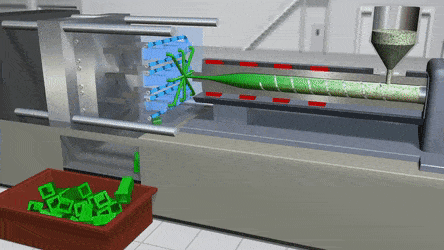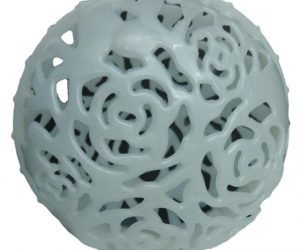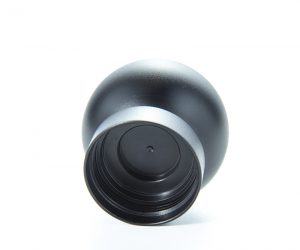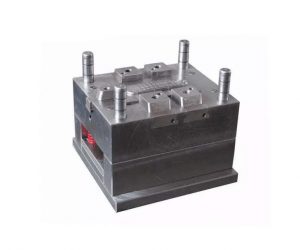about Plastic injection molding. It's a process that churns out millions of plastic parts daily. we'll break down the Plastic injection molding process step by step, from melting plastic to producing huge quantities of parts. We'll cover the basics, like key terms and manufacturing techniques, as well as some common uses. By the end of this, you'll be an Plastic injection molding pro - no more mystery, just a solid understanding of this game-changing way to make plastic products. from mold7.
What is Plastic Injection Molding?
Plastic Injection molding is a widely used manufacturing process for producing plastic parts in large volumes. It involves injecting molten material, typically thermoplastics, into a mold cavity under high pressure. The material then cools and solidifies, taking the shape of the mold, and is subsequently ejected as a finished part.
The Basics of Plastic Injection Molding
Plastic Injection molding is a manufacturing process based on the principle of using molds to shape molten material into the desired shape. This process starts with the preparation of the mold, which consists of two parts - the cavity and the core. These two parts undergo precise mechanical processing to create the shape and features required for the final component.
The materials used in Plastic injection molding are usually small particles or granules, known as resins. These resins are fed into a heated cylinder where they are melted and controlled at a specific temperature. Then, the molten material is injected into the mold cavity through a flow channel system, which ensures that the material is evenly distributed throughout the mold.
Once the molten resin is injected into the mold, it quickly cools and solidifies, forming a hard plastic component. This process requires precise temperature control and time management to ensure the quality of the components. During the Plastic injection molding process, various colors and additives can also be added to enhance the performance or appearance of the components.
So you want to know about Plastic injection molding? It's actually a really efficient and precise way to make plastic parts in all sorts of shapes and sizes. Lots of industries rely on it, like the automotive and medical fields, as well as companies that make consumer electronics and packaging. The great thing about injection molding is that by using different materials and clever mold designs, you can create really high-quality components with intricate details and super accurate dimensions.
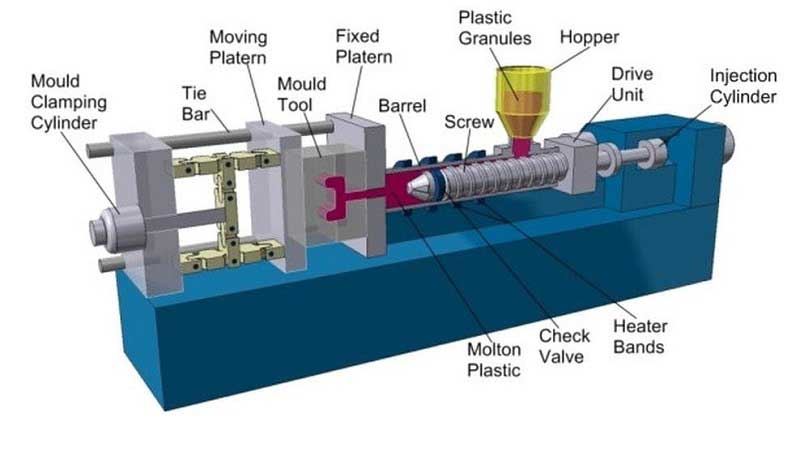
Plastic Injection Molding Processing
The Plastic Injection Molding Process
The Plastic injection molding process can be divided into several stages:
- Clamping: The mold is securely closed and held in place by a clamping unit. This ensures that the mold remains closed during the injection and cooling phases.
- Injection: The molten material is injected into the mold cavity under high pressure. The injection unit pushes the material through the nozzle and into the mold at a controlled rate and pressure.
- Cooling: After the material is injected, it begins to cool and solidify within the mold cavity. Cooling channels integrated into the mold help dissipate heat and accelerate the cooling process.
- Dwelling: Once the material has cooled sufficiently, it is kept under pressure for a specific period, known as the dwelling time. This helps to compensate for shrinkage and ensures that the part maintains its shape and dimensions.
- Ejection: The molded part is ejected from the mold cavity using ejector pins or other ejection mechanisms. The mold then opens, ready for the next molding cycle.
Advantages of Plastic Injection Molding
Plastic Injection molding offers several advantages that make it a preferred choice for manufacturing plastic parts:
- High Efficiency: Plastic Injection molding allows for the production of large volumes of parts with high precision and repeatability. The automated nature of the process enables fast cycle times and high production rates.
- Design Flexibility: The versatility of Plastic injection molding enables complex part geometries, including intricate details and features such as undercuts, threads, and logos. This flexibility allows for the creation of custom parts to meet specific design requirements.
- Material Variety: Plastic Injection molding supports a wide range of thermoplastic materials, including commodity plastics, engineering plastics, and high-performance polymers. This versatility enables the production of parts with varying mechanical, chemical, and thermal properties.
- Cost-Effectiveness: Once the initial mold is created, the cost per part in Plastic injection molding decreases significantly. This makes it an economical choice for large production runs, reducing per-unit costs over time.
- Reduced Waste: Plastic Injection molding generates minimal waste as any excess material can be reused for subsequent molding cycles. Additionally, the use of automated processes and precise control over material flow reduces material wastage.
Applications of Plastic Injection Molding
Plastic Injection molding is utilized in a wide range of industries and applications, including:
- Automotive: Plastic Injection molding is widely used in the automotive industry for manufacturing interior and exterior components, such as dashboards, bumpers, and door panels.
- Consumer Goods: Many consumer goods, including household appliances, electronic devices, and packaging products, are produced through Plastic injection molding.
- Medical: Plastic Injection molding is employed to manufacture various medical devices and components, such as syringes, IV components, and surgical instruments.
- Aerospace: Plastic Injection molding is utilized in the aerospace industry for producing lightweight, high-strength components, such as interior panels and aircraft seating.
- Electronics: Plastic Injection molding is used to manufacture a wide range of electronic components, including connectors, housings, and switches.
In conclusion, Plastic injection molding is a versatile and efficient manufacturing process that enables the production of high-quality plastic parts. Its advantages, including high efficiency, design flexibility, and cost-effectiveness, make it a popular choice across various industries. Understanding the basics of Plastic injection molding is essential for anyone interested in the manufacturing and design of plastic parts.
The Injection Molding Machine
The injection molding machine is a key component in the injection molding process. It is responsible for melting the raw material, injecting it into the mold cavity, applying pressure, and controlling the various parameters of the molding cycle. Let's take a closer look at the different elements and functions of the injection molding machine.
Machine Components
- Injection Unit: The injection unit of the machine consists of a hopper, a screw or plunger, and a barrel. The raw material, in the form of pellets or granules, is fed into the hopper. The screw or plunger rotates or reciprocates to melt and transport the material into the mold.
- Clamping Unit: The clamping unit is responsible for securely closing and holding the mold during the injection and cooling phases. It consists of a movable and a fixed platen, which apply the necessary force to keep the mold closed.
- Hydraulic or Electric System: Injection molding machines can be powered by hydraulic or electric systems. The hydraulic system uses hydraulic pumps, valves, and cylinders to control the various machine movements, such as clamping, injection, and ejecting. Electric machines, on the other hand, utilize electric motors and servo drives for precise control and energy efficiency.
- Control System: The control system of the injection molding machine allows operators to set and monitor various parameters of the molding process, such as temperature, pressure, injection speed, and cooling time. It ensures the machine operates within the desired parameters for consistent and high-quality part production.
Machine Functions
- Melting and Injection: The injection molding machine heats the raw material in the barrel to a molten state. In the case of screw injection machines, the rotating screw applies pressure and conveys the molten material towards the mold. In plunger machines, the reciprocating plunger generates the necessary pressure for material injection.
- Clamping: Once the molten material is injected into the mold, the clamping unit of the machine applies force to keep the mold closed. The clamping force ensures that the mold cavity remains filled and that the part takes the desired shape. The clamping force is determined based on the material properties, part design, and mold requirements.
- Cooling and Solidification: After the material is injected into the mold, the cooling phase begins. The machine controls the cooling time and temperature to allow the material to solidify and take the shape of the mold cavity. Cooling channels integrated into the mold assist in dissipating heat and accelerating the cooling process.
- Ejection: Once the part has solidified, the machine initiates the ejection process. Ejector pins or other mechanisms push the part out of the mold cavity, allowing for its removal. The mold then opens, and the part is ready for extraction.
The Molding Cycle Process
The injection molding process consists of a series of sequential steps that make up the molding cycle. Understanding the molding cycle process is crucial for optimizing production efficiency and part quality. Let's explore the different stages of the molding cycle:
- Mold Closing: The mold, consisting of two halves, is closed and clamped together by the machine's clamping unit. The mold halves are aligned to ensure proper part formation.
- Injection: Once the mold is closed, the raw material is fed into the injection unit. The material is heated and melted, and the screw or plunger injects it into the mold cavity under high pressure. The injection speed, pressure, and volume are carefully controlled to achieve optimal part filling.
- Dwelling and Cooling: After the material is injected, it dwells in the mold cavity for a specific period, known as the dwelling time. This allows for proper packing of the material and compensates for any shrinkage that may occur during cooling. Cooling channels within the mold facilitate the solidification of the material by dissipating heat.
- Mold Opening and Ejection: Once the material has sufficiently cooled and solidified, the mold opens, and the machine initiates the ejection process. Ejector pins or other mechanisms push the part out of the mold cavity. The mold is then ready for the next cycle.
- Mold Closing and Purging: After the part is ejected, the mold halves close again, and any remaining material in the injection unit is purged out. Purging helps ensure that the next shot of material is free from any contamination or color mixing.
The duration of the molding cycle depends on various factors, including the part size, material characteristics, cooling time, and machine capabilities. Optimizing the cycle time is essential to maximize production efficiency without compromising part quality.
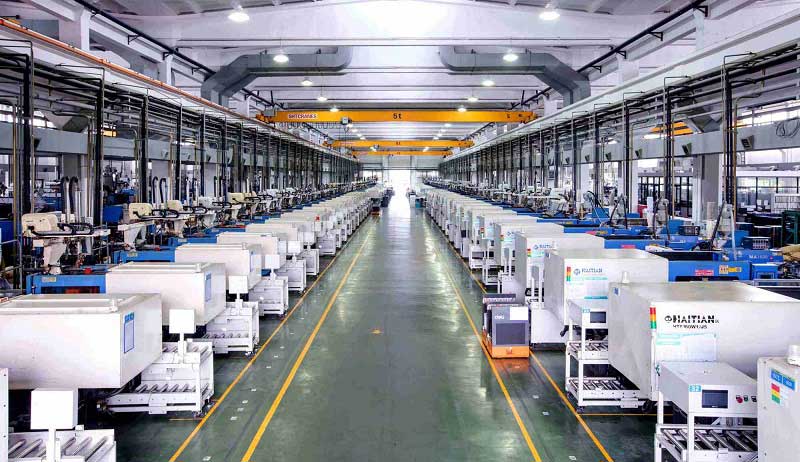
Plastic injection Molding Factory workshop
Cycle Time Optimization
Reducing the cycle time can significantly increase production output and efficiency. Several strategies can be employed to optimize the molding cycle:
- Material Selection: Choose materials with shorter cooling times or faster solidification properties to speed up the overall cycle.
- Mold Design: Optimize thecooling system within the mold by incorporating efficient cooling channels. Properly designed cooling channels help dissipate heat quickly, reducing cooling time and overall cycle time.
- Machine Settings: Fine-tune the machine parameters, such as injection speed, pressure, and cooling time, to achieve the shortest possible cycle time without compromising part quality.
- Automation and Robotics: Implement automation and robotics systems to streamline the molding process. Automated part removal, mold opening and closing, and material handling can reduce cycle time by eliminating manual steps and improving overall efficiency.
- Mold Maintenance: Regularly maintain and clean the mold to ensure smooth and efficient operation. Proper maintenance prevents issues such as sticking, flashing, or uneven cooling, which can prolong the cycle time.
By implementing these optimization strategies, manufacturers can achieve shorter cycle times, increased production capacity, and improved overall efficiency in the injection molding process.
In conclusion, the Plastic injection molding machine is a vital component in the Plastic injection molding process. It melts the raw material, injects it into the mold, applies pressure, and controls various parameters to produce high-quality plastic parts. Understanding the machine components and functions, as well as optimizing the molding cycle, is essential for successful Plastic injection molding operations.
Common Plastics Used in Injection Molding
Injection molding supports a wide range of thermoplastic materials, each with its unique properties and characteristics. The choice of plastic depends on factors such as part design, required mechanical properties, chemical resistance, and cost considerations. Let's explore some of the most commonly used plastics in injection molding:
1. Polyethylene (PE)
Polyethylene is a versatile plastic known for its excellent impact resistance, flexibility, and low cost. It is available in various forms, including high-density polyethylene (HDPE) and low-density polyethylene (LDPE). PE is commonly used in the production of bottles, containers, toys, and household goods.
2. Polypropylene (PP)
Polypropylene is a lightweight and durable plastic with excellent chemical resistance. It offers high tensile strength, good impact resistance, and is resistant to moisture and fatigue. PP is widely used in automotive parts, packaging, appliances, and consumer goods.
3. Acrylonitrile Butadiene Styrene (ABS)
ABS is a popular engineering plastic known for its excellent impact strength, rigidity, and heat resistance. It is easy to process, has good dimensional stability, and can be easily colored or textured. ABS is commonly used in automotive components, electronic housings, toys, and consumer appliances.
4. Polycarbonate (PC)
Polycarbonate is a transparent and highly impact-resistant plastic. It has excellent heat resistance, good electrical insulation properties, and high optical clarity. PC is commonly used in automotive lighting, electronic components, safety helmets, and medical devices.
5. Polyethylene Terephthalate (PET)
PET is a strong and lightweight plastic known for its excellent clarity, barrier properties, and recyclability. It is commonly used in the production of bottles for beverages, food containers, and packaging materials.
6. Polyvinyl Chloride (PVC)
Polyvinyl Chloride is a versatile plastic that can be rigid or flexible, depending on the formulation. It offers good chemical resistance, durability, and flame retardancy. PVC is widely used in construction products, electrical cables, pipes, and vinyl flooring.
7. Nylon (Polyamide)
Nylon is a strong and durable engineering plastic with excellent mechanical properties. It offers high tensile strength, good impact resistance, and low friction. Nylon is commonly used in automotive parts, electrical connectors, gears, and industrial components.
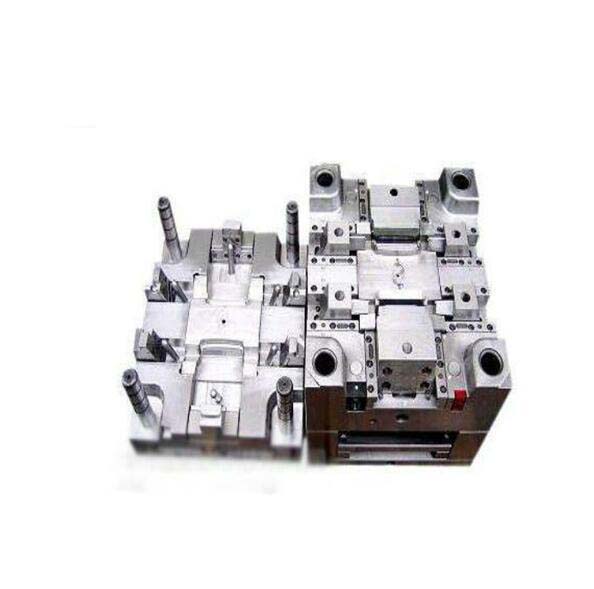
Plastic injection Molding Tool Mold
Popular Applications of Plastic Injection Molding
Plastic Injection molding finds applications in various industries due to its versatility, efficiency, and ability to produce complex parts. Some popular applications include:
1. Automotive Industry
Injection molding plays a significant role in the automotive industry, producing a wide range of interior and exterior components. This includes dashboards, door panels, bumpers, seat components, instrument panels, and interior trims. Injection molding enables the production of lightweight, durable, and aesthetically appealing parts for cars, trucks, and motorcycles.
2. Consumer Goods
Injection molding is widely used for manufacturing consumer goods such as household appliances, electronic devices, and packaging products. It produces components like buttons, knobs, casings, covers, and enclosures for items like refrigerators, washing machines, televisions, smartphones, and kitchen appliances. Injection molding allows for high-volume production of consistent and high-quality parts for consumer goods.
3. Medical Industry
The medical industry heavily relies on injection molding for the production of various medical devices and components. This includes syringes, IV components, surgical instruments, drug delivery systems, diagnostic equipment, and laboratory consumables. Injection molding ensures the production of precise, sterile, and biocompatible parts that meet strict regulatory requirements.
4. Aerospace Industry
Injection molding is utilized in the aerospace industry for manufacturing lightweight, high-strength components. This includes interior panels, seat components, air ducts, brackets, and housings. The ability to produce complex geometries and the use of advanced materials make injection molding an ideal choice for aerospace applications.
5. Electronics Industry
The electronics industry relies on injection molding for the production of various components used in electronic devices. This includes connectors, housings, switches, buttons, and display bezels. Injection molding enables the production of precise, dimensionally stable, and aesthetically appealing parts for electronic devices.
In addition to these industries, injection molding is also used in sectors such as telecommunications, furniture manufacturing, sports equipment, and industrial machinery. The versatility of injection molding allows for the production of custom parts with intricate designs and specific performance requirements.
In conclusion, injection molding supports a wide range of plastics and finds applications in various industries. Its ability to produce complex parts with high efficiency and precision makes it a preferred choice for manufacturers across different sectors. The choice of plastic depends on the desired properties of the final part, while the applications of injection molding span from automotive and consumer goods to medical devices and aerospace components.
Advantages of Injection Molding
Injection molding offers numerous advantages that make it a popular and widely used manufacturing process. Some key advantages include:
1. High Efficiency and Production Speed
Injection molding is a highly efficient process that allows for the production of large quantities of parts with consistent quality. Once the mold is set up, the cycle time for each part is relatively short, enabling high-volume production. This efficiency makes injection molding cost-effective for mass production.
2. Design Flexibility
Injection molding allows for the production of complex parts with intricate designs and precise details. The process can accommodate various geometries, including thin walls, undercuts, and internal features. This design flexibility opens up possibilities for innovative and creative part designs.
3. Wide Range of Material Options
Injection molding supports a wide range of thermoplastic materials with different properties and characteristics. Manufacturers can choose from a variety of plastics to meet specific requirements such as strength, flexibility, heat resistance, chemical resistance, and more. This versatility in material selection allows for the production of parts with desired properties.
4. Consistent and High-Quality Parts
Injection molding ensures consistent quality in each produced part. The process involves precise control of various parameters, including temperature, pressure, and cooling time. This control results in uniform part dimensions, minimal variations, and high repeatability. The use of molds also helps in achieving consistent part quality.
5. Cost-Effective for Mass Production
Injection molding is cost-effective for large-scale production due to its high efficiency and relatively low per-unit cost. The initial setup costs for creating molds can be significant, but once the molds are made, the cost per part decreases significantly. Additionally, the automation and high-speed production of injection molding contribute to cost savings.
6. Reduced Waste and Material Recycling
Injection molding generates minimal waste compared to other manufacturing processes. The excess material from the sprue and runners can be recycled and reused, reducing material waste. The recyclability of many thermoplastic materials used in injection molding further contributes to environmental sustainability.
7. Automation and Process Control
Injection molding can be highly automated, reducing the need for manual labor and ensuring consistent production quality. Automated systems handle tasks such as material feeding, mold opening and closing, part ejection, and quality control. Additionally, advanced control systems monitor and adjust process parameters in real-time, resulting in improved process control and part quality.
Frequently Asked Questions about Injection Molding
Here are some commonly asked questions about injection molding:
1. What is the typical delivery cycle for producing injection molded parts?
The delivery cycle for producing injection molded parts depends on various factors, including the complexity of the parts, mold design and manufacturing time, material selection, and production volume. Simple parts with ready-made molds can be produced in a few days, while more complex parts may require several weeks of mold manufacturing and setup.
2. What is the maximum size of parts that can be produced through injection molding?
The maximum size of parts that can be produced through injection molding depends on the specific performance of the injection molding machine and the size of the mold. Injection molding machines come in various sizes, from small machines that produce small parts to large machines that can produce larger parts.
3. Can injection molding be used for prototyping?
The capital expenditure inherent in injection mold fabrication constitutes a multifaceted equation, defying simplistic cost projections. Nuances in part geometry, extending beyond mere "complexity" to encompass intricate undercuts, delicate features demanding specialized machining techniques, and the presence of highly variable wall thicknesses, significantly impact tooling costs. Mold dimensions, far from being a straightforward scalar, interact nonlinearly with material selection and the desired surface finish. A high-gloss finish, for instance, necessitates advanced polishing and potentially the incorporation of specialized mold inserts, escalating expenses disproportionately.
The ostensibly straightforward categorization of costs into design, material, and manufacturing obscures the intricate interplay between these factors. Design costs, themselves, are not static; iterative design revisions, driven by factors ranging from manufacturability challenges to unforeseen thermal considerations, can lead to unpredictable cost overruns. Material selection, while seemingly a discrete choice, involves a complex trade-off between cost, durability, and the mold's thermal performance, impacting both initial material costs and the mold's lifespan, thereby influencing long-term production economics. Furthermore, manufacturing costs are heavily influenced by the chosen fabrication method, with high-precision molds often requiring specialized machining processes, dramatically increasing the overall expenditure.
The number of cavities, while seemingly a simple multiplier, introduces further complexity. While increasing cavity count theoretically reduces per-unit cost, it simultaneously increases the mold's overall size and intricacy, potentially leading to unexpected challenges in manufacturing and quality control, offsetting projected economies of scale. Therefore, a comprehensive cost analysis necessitates a holistic approach, considering not only individual cost components but also their synergistic and often unpredictable interactions, demanding a deep understanding of both injection molding processes and the specific demands of the target component.
4. What is the cost of manufacturing injection molds?
The capital expenditure inherent in injection mold fabrication constitutes a multifaceted equation, defying simplistic cost projections. Nuances in part geometry, extending beyond mere "complexity" to encompass intricate undercuts, delicate features demanding specialized machining techniques, and the presence of highly variable wall thicknesses, significantly impact tooling costs. Mold dimensions, far from being a straightforward scalar, interact nonlinearly with material selection and the desired surface finish. A high-gloss finish, for instance, necessitates advanced polishing and potentially the incorporation of specialized mold inserts, escalating expenses disproportionately.
The ostensibly straightforward categorization of costs into design, material, and manufacturing obscures the intricate interplay between these factors. Design costs, themselves, are not static; iterative design revisions, driven by factors ranging from manufacturability challenges to unforeseen thermal considerations, can lead to unpredictable cost overruns. Material selection, while seemingly a discrete choice, involves a complex trade-off between cost, durability, and the mold's thermal performance, impacting both initial material costs and the mold's lifespan, thereby influencing long-term production economics. Furthermore, manufacturing costs are heavily influenced by the chosen fabrication method, with high-precision molds often requiring specialized machining processes, dramatically increasing the overall expenditure.
The number of cavities, while seemingly a simple multiplier, introduces further complexity. While increasing cavity count theoretically reduces per-unit cost, it simultaneously increases the mold's overall size and intricacy, potentially leading to unexpected challenges in manufacturing and quality control, offsetting projected economies of scale. Therefore, a comprehensive cost analysis necessitates a holistic approach, considering not only individual cost components but also their synergistic and often unpredictable interactions, demanding a deep understanding of both injection molding processes and the specific demands of the target component.
5. Can injection molded parts be colored or textured?
The chromatic and tactile properties of injection-molded components are entirely malleable. Pre-injection pigmentation of the thermoplastic resin affords virtually limitless color options, transcending the limitations of post-process treatments. Furthermore, the mold itself serves as a deterministic agent, imprinting intricate surface textures – ranging from mirror-smooth finishes to complex, multi-faceted patterns – onto the nascent part. The very grain of the final product, its haptic signature, is dictated by the meticulous engineering of the mold cavity. Surface treatments, extending beyond simple texturing, can introduce functionalities such as enhanced lubricity, chemical resistance, or even biocompatibility, depending on the chosen process and materials.
Plastic Injection molding's ascendancy within manufacturing stems from a confluence of compelling advantages. Its inherent efficiency, facilitated by automation and high-volume production, translates to significant cost reductions, particularly for large-scale projects. The design flexibility is equally remarkable, accommodating intricate geometries and complex undercuts that would defy alternative fabrication methods. The expansive palette of available thermoplastic and thermoset materials further broadens its applicability across diverse sectors. Precision and consistency are hallmarks of the process, minimizing material waste and maximizing yield. However, the seemingly seamless execution belies inherent complexities.
The operational landscape of Plastic injection molding is not without its challenges. Lead times, often dictated by mold fabrication and iterative design refinements, can be substantial. Dimensional constraints, imposed by the press's capabilities and the inherent limitations of the molding process, restrict the maximum achievable part size. The feasibility of rapid prototyping, while improving, remains a critical consideration, especially for intricate designs. The significant upfront investment in mold creation, a crucial factor influencing overall project economics, necessitates careful planning and risk assessment. Finally, while the options for color and texture are extensive, achieving specific aesthetic or functional surface properties may necessitate specialized mold treatments and potentially increase costs. A nuanced understanding of these factors is paramount for successful implementation.
